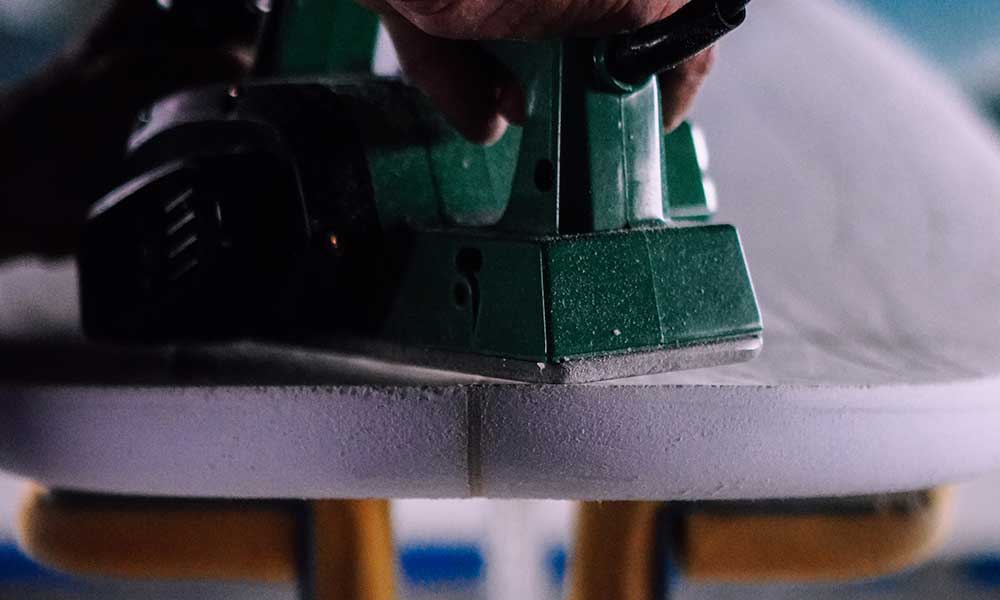One of the first decisions that you need to make when purchasing a new surfboard is whether to opt for a fiberglass surfboard or an epoxy surfboard.
There are other types out there, but these are the main ones and there are differences in durability, performance, and environmental impact to consider.
So, when you take your first steps as an aspiring surfer, which type of surfboard is best?
Fiberglass Surfboards
Also known as polyurethane or PU surfboards, fiberglass surfboard are the more traditional option and have been around for more than half a century.
They are made from an inner of polyurethane foam that is coated in a fiberglass cover.
The foam provides buoyancy and ensures that the surfboard is lightweight, and the fiberglass cloth helps to protect it from the water.
Pros of a Fiberglass Surfboard
A fiberglass surfboard cuts through the chop very well as it sits low in the water.
It will benefit you when paddling out to the swell and when riding the waves.
It also has better flex, and on a purely visual level, there is a wider choice of color and graphic options with a fiberglass surfboard as it has a smoother and more transparent surface.
Cons of a Fiberglass Surfboard
Fiberglass surfboards can be pretty harmful to the environment, with most of these boards sent to landfill and with a chunk of carbon pumped into the atmosphere during their creation.
The environment is pretty harmful to them, as well, as the surfboards are susceptible to sun damage and are more likely to pick up dings and dents as they are surfed and transported.
The foam core is also denser and so the surfboard tends to be heavier, although it’s still fairly light and you shouldn’t really have an issue carrying or riding that extra weight.
Epoxy Surfboards
Epoxy surfboards are made from polystyrene foam and an epoxy resin cover.
The surfboards are also known as “EPS” surfboards as the blank is made from a specific type of polystyrene known as Expanded Polystyrene or “EPS”.
These surfboards became more common during the 1990s, but they experienced a massive popularity explosion in the 2005s when the closure of a major PU foam factory sent shapers and surfers in search of new materials.
Pros of an Epoxy Board
Epoxy surfboards are lighter and stronger and as EPS foam is much less dense than PU, they are also more buoyant.
The foam blanks break down rapidly and can also be recycled, making it an eco-friendlier option, as well.
Epoxy surfboards are also thought to be less prone to waterlogging than fiberglass boards.
Waterlogging occurs gradually over time as the surfboard takes on water.
It takes on a yellow tinge and becomes heavier and heavier.
Cons of an Epoxy Board
As with fiberglass surfboards, epoxy surfboards are also susceptible to sun damage and heat, as the foam inside can expand and cause some serious damage.
It’s important, therefore, to keep the surfboards covered up and make sure it’s not sitting out on the beach or resting against a radiator.
Epoxy surfboards have less flex and can feel overly bouncy, making them feel much stiffer and more awkward at times.
Which is Best for a Beginner?
As you can see, there are many differences between a fiberglass surfboard and an epoxy surfboard, and to a professional surfer, these differences can be substantial.
For a beginner, however, you’re probably not going to notice it.
It’s not something you really need to stress over, as there are more important decisions to make when you buy your first surfboard, including whether you should buy a shortboard or a longboard (usually the latter) and how much you should spend.
Find a surfboard that is within your budget, has an ideal length and volume, and looks good. Try not to spend too much and go from there.
Over time, as your skills improve, you will learn more about surfboard construction and the nuances that differentiate one type of board from the next.
It will help you when you purchase a new surfboard and make a step-up, but in those very early days, it’s best not to over-complicate things.







